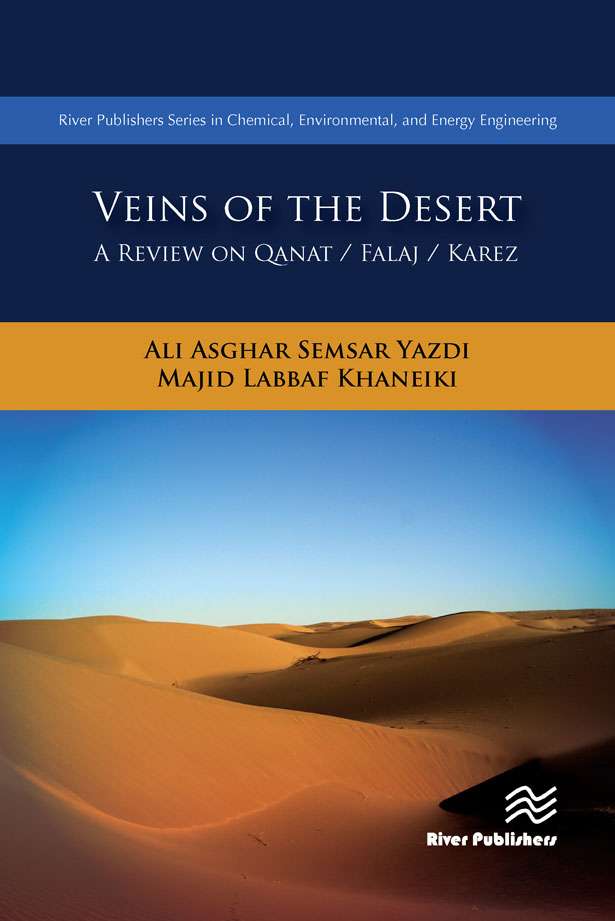
Veins of the Desert
A Review on Qanat / Falaj / Karez
River Publishers Series in Other Technologies
Veins of the Desert
A Review on Qanat / Falaj / Karez
Authors:
Ali Asghar Semsar Yazdi, UNESCO-ICQHS
Majid Labbaf Khaneiki, UNESCO-ICQHS
ISBN: 9788770220842 e-ISBN: 9788770220835
Available: May 2019
Qanat is a gently sloping subterranean canal, which taps a water-bearing zone at a higher elevation than cultivated lands. A qanat consist of a series of vertical shafts in sloping ground, interconnected at the bottom by a tunnel with a gradient flatter than that of the ground. From the air, this system looks like a line of anthills leading from the foothills across the desert to the greenery of an irrigated settlement. Qanat engages a variety of knowledge and its studying entails an interdisciplinary approach. In a traditional realm, qanats are embraced by a socio-economic system which guarantees their sustainability.
The facets of this socio-economic system operate closely together and make it possible for the qanats to remain into future.
Veins of the Desert shows that digging a qanat requires a variety of sciences and technologies, though at a glance qanat is just a horizontal tunnel which drains out groundwater. Qanat is a feat of technology left from our ancestors; hidden underground, but its technical importance is apparent, not less valuable than such surface structures as bridges, castles, towers, etc. Qanat enjoys extended structures and sometimes its length reaches tens of kilometers. It passes through geological formations and faces different conditions and obstacles, so the qanat masters' efforts to solve these problems led to the accumulation of knowledge in terms of qanat construction over time, which has been handed down from generation to generation. Qanat is one of the most complicated traditional technologies, which require knowledge on nature ranging from groundwater to management. This indigenous technology used to bring water efficiently from tens of kilometers away to the thirsty lands.
This book also gives insight into cultural and social heritages, which have crystalized around this technique. This cultural heritage still influences social life of the people living in such regions as central plateau of Iran where qanat has been the only means of supplying water. This technology is the focal point of the genesis of a particular civilization in the arid and semi-arid regions of Iran. The harsh environment drove those people to invent the technology of qanat and the know-how revolving around it. Qanat carries a tradition of science and technology which used to be practiced in order to overcome the technical obstacles in qanat construction. Thus, qanat is not only an irrigational means, but it should be seen as a technical and cultural legacy which deserves more attention. This book is a small encyclopedia on qanat system, providing the readers with easy answers to their questions about different aspects of this ancient technology.
The facets of this socio-economic system operate closely together and make it possible for the qanats to remain into future.
Veins of the Desert shows that digging a qanat requires a variety of sciences and technologies, though at a glance qanat is just a horizontal tunnel which drains out groundwater. Qanat is a feat of technology left from our ancestors; hidden underground, but its technical importance is apparent, not less valuable than such surface structures as bridges, castles, towers, etc. Qanat enjoys extended structures and sometimes its length reaches tens of kilometers. It passes through geological formations and faces different conditions and obstacles, so the qanat masters' efforts to solve these problems led to the accumulation of knowledge in terms of qanat construction over time, which has been handed down from generation to generation. Qanat is one of the most complicated traditional technologies, which require knowledge on nature ranging from groundwater to management. This indigenous technology used to bring water efficiently from tens of kilometers away to the thirsty lands.
This book also gives insight into cultural and social heritages, which have crystalized around this technique. This cultural heritage still influences social life of the people living in such regions as central plateau of Iran where qanat has been the only means of supplying water. This technology is the focal point of the genesis of a particular civilization in the arid and semi-arid regions of Iran. The harsh environment drove those people to invent the technology of qanat and the know-how revolving around it. Qanat carries a tradition of science and technology which used to be practiced in order to overcome the technical obstacles in qanat construction. Thus, qanat is not only an irrigational means, but it should be seen as a technical and cultural legacy which deserves more attention. This book is a small encyclopedia on qanat system, providing the readers with easy answers to their questions about different aspects of this ancient technology.
Qanat, water history, traditional irrigation, hydraulic civilization, traditional water knowledge, indigenous water technology, groundwater mining, indigenous water management



